Local Area Networks
-
- Intelligent Software Agents for Machinery Diagnostics Maritime Reporter, Dec 2001 #47
Machinery plant maintenance represents a major expense for ship operators. In addition to normal maintenance expenditures, unexpected breakdowns have a significant cost impact. Recognizing the importance of preventing equipment failures, companies continue to adopt automation for machinery monitoring at a rapid pace. Continual improvements in the price/performance ratio of automation systems have also fueled their increased use in shipboard machinery plant monitoring.
As a result, more ships with automated machinery plants exist today than ever before. However, just as a typical Internet search can easily create "information overload", so too can process automation create a "data overload" situation for the engineering crews responsible for equipment operation and maintenance. Modern shipboard automation systems typically monitor upwards of over 5,000 real-time process variables, allowing engineers to view massive amounts of data.
This is one example of how automation systems can create too much data. Who is responsible for or has the time to monitor the 5,000 data points? How many people will this take and how much will it cost?
The trends toward more automation, too much data, and too few people make it difficult for companies to assimilate data into information useful for optimal maintenance management. Machinery performance monitoring and maintenance management is an area where immediate exploitation of software agent technology can yield substantial benefits. Software agents can serve as expert assistants in monitoring, controlling, and troubleshooting complex machinery processes.
Agents can perform tedious, repetitive, and analytically complex tasks without being constantly controlled by people. They can also provide valuable assistance in maintenance management decision-making.
Meet Dexter MACSEA has offered its DEXTER machinery diagnostic system since 1991. This system monitors alarm conditions, detects trends, diagnoses machinery faults, and predicts impending problems. DEXTER's artificial intelligence is based on neural network technology that diagnoses machinery faults and ranks them by their probability. The company has recently adapted its diagnostic technology into a team of cooperating, real-time agents, allowing users to create as many agent assistants as needed for their particular condition monitoring requirements. The agents "plug-and-play" with most process control software and automation systems in use throughout industry. Tools are provided to build diagnostic knowledgebases that cause neural networks to be created automatically. The neural networks are then attached to different agents, which gives them the artificial intelligence to carry out their monitoring and diagnostic tasks.
DEXTER's agents run continuously in the background under Windows NT. Users can deploy multiple agents simultaneously, with each monitoring a different piece of equipment. Human-like animated characters provide a simple user-agent interface employing the latest speech synthesis and recognition technologies.
Agent characters issue alerts only when they have diagnosed or predicted problems in the machinery plant. They appear on a computer screen, no matter what other software you may be running at the time. At other times, the agent characters remain hidden, working silently in the background. Since the agents are designed to run in a Windows NT environment, distributed operation over local area networks is supported.
With machinery plant maintenance often accounting for up to 40 percent of total costs in a company, clearly knowledge assets in the maintenance area can be valuable. DEXTER is a tool that allows an organization to capture, organize, manage, and distribute machinery diagnostic knowledge assets within your organization. Even the newest maintenance worker can immediately benefit from your diagnostic knowledge assets that are embedded into DEXTER's neural networks.
This knowledge can be distributed and exploited across your entire maintenance operation, be it contained in a single factory or in several locations around the globe. The bottom line will be improved profitability through avoiding, reducing, or eliminating the consequences of machinery failures. Downtime due to equipment failure impacts both profitability and productivity by reducing output, increasing operating costs, and interfering with customer service. Maintenance plays a critical role in preserving the physical, financial, and competitive health of your company.
Smart companies need to equip themselves now with smart tools for condition-based maintenance; smart tools like DEXTER.
Cloning Human Intelligence A knowledgebase encapsulates valuable engineering knowledge about a machinery plant and its equipment.
A knowledgebase is typically developed through an expert-level assessment of machinery failure modes. In maintenance circles, this is called a Failure Mode and Effects Analysis (FMEA) of the machinery plant. The FMEA involves enumerating all likely machinery faults based on information gathered from historical experience, manufacturers' troubleshooting information, and assessments of industry experts. Each fault is then characterized by its measurable symptoms in the plant, as monitored by the available sensor instrumentation and plant automation. A symptom is defined as an alarm condition, such as a particular temperature measuring HIGH, with respect to a set point limit.
The FMEA forms the basis of diagnostic knowledge about the plant. A comprehensive FMEA of a machinery plant typically involves a substantial amount of time and effort. Because of this, any knowledgebase created from the FMEA becomes a valuable corporate intellectual asset, particularly when it is used with DEXTER as part of a condition-based, reliability-centered maintenance program. A knowledgebase is a collection of information relating machinery faults and symptoms derived from the FMEA.
The BRAINS tool allows a user to create and manage diagnostic knowledgebases that are used by DEXTER's agents. DEXTER's diagnostic neural networks automatically learn the fault-symptom relationships you enter into each knowledgebase. Its software agents are then able to perform real-time diagnostics and prognostics of machinery plant problems.
Besides entering a fault name and description, a user can also indicate any corrective actions or special instructions that the maintenance engineer should follow if the fault is detected. The information entered on this form will be displayed when this fault is detected by one of DEXTER's diagnostic agents.
When specifying symptoms in BRAINS, a list of available tag names and their descriptions are obtained directly through the interface between DEXTER and a user's automation system.
For example, if the automation software defines a Process Database containing all measured sensor inputs in the plant, DEXTER interrogates the automation software for this list. A user can then simply pick from a drop-down list of data points when building a diagnostic. This makes it very easy for a user to integrate DEXTER into plant automation.
The various software agents within DEXTER are "knowledgebase- centric". This means that each agent is linked to a specific knowledgebase. The knowledgebase defines both the data source and the specific data points that an agent will monitor. Because DEXTER agents are knowledgebase-centric, the amount of setup information that you must specify to configure an agent is kept to a minimum. A user simply select a knowledgebase to be used by your agent and it then knows exactly which set of data points to monitor.
Before a user builds any knowledgebases, a user must first configure DEXTER to work with a specific a real-time data source. DEXTER is designed for interoperability with most of the major process control software packages on the market, such as Intellution FIX, Wonderware, Rockwell Automation, National Instruments, etc. All of these software packages have a mechanism for storing real-time sensor data in a database.
BRAINS will automatically extract a list of all data points defined in the process control software database. The user will then be able to select data points from this list when the faults and symptoms for a knowledgebase are entered.
A user can create multiple knowledgebases using BRAINS, storing each one under a different name. Each knowledgebase can pertain to a separate machinery plant, specific system within a plant, or even an individual piece of equipment. A user has complete flexibility in how knowledgebases are defined and used. A user should consider what types and how many agents are desired when creating knowledgebases.
Transforming Knowledge into Artificial Intelligence A major concern in deploying software agents for diagnostics and prognostics is the robustness of their artificial reasoning with respect to correctly identifying real problems when they occur. Missing, noisy, or corrupted sensor data, which are all common real-world occurrences, must be tolerated and not mistaken as equipment faults. Faulty sensor data introduces uncertainty into the diagnostic inferencing process. The reasoning technique should handle such uncertainties in some statistically valid way. The diagnostic agent's robustness can directly impact maintenance and repair costs.
Robustness can be quantified by the accuracy of the diagnostic call. An incorrect diagnosis is declaring a fault different from the one actually present. A missed diagnosis is declaring that nothing is wrong, when, in fact, one or more faults exist. A false alarm involves declaring a fault when there is none. Each of these diagnostic conditions can lead to unnecessary expenditures of maintenance resources and/or reductions in plant reliability, not to mention loss of faith in the diagnostic system. DEXTER's goal is to minimize the probability of each of these cases and to maximize the probability of a correct diagnosis.
DEXTER uses probabilistic neural networks for its diagnostic and prognostic reasoning about machinery faults.
DEXTER's neural networks automatically learn to associate patterns of alarm conditions with the machinery faults you enter into your knowledgebases. DEXTER's neural network learning occurs instantaneously, as compared to other neural network techniques, allowing you to rapidly build, modify, and deploy diagnostic agents on the factory floor. This allows you to immediately put agents to work, without any programming.
DEXTER agent characters are driven by Microsoft Agent software.
-
- Will Paper Logs Sail into History? Marine News, Mar 2015 #30
offers two software suites, Helm Marine Operations Software (MOS) and Helm CONNECT. Helm MOS, the older program, relies on installed software and Local Area Networks to transmit from vessel to shore. Helm CONNECT customers use the web. Both use an intuitive interface to record data and sync it back and forth
-
- NAVIGATION & COMMUNICATIONS Maritime Reporter, Mar 1992 #64
, secure terminals, satellite communications and shore-based telephone systems. It can also be configured for use with fiber optic systems and local area networks. Custom-tailored for shipboard applications, the Definity system has custom circuitry and international software. These provide the connectivity
-
 )
March 2024 - Marine Technology Reporter page: 37
)
March 2024 - Marine Technology Reporter page: 37miscible barrier ? uid heavier than seawater (sg=1.026) and lighter than the battery electrolyte (sg=1.265). The original cell vent cap was screwed into the top of the riser pipe to vent the gases associated with charging. Wires were soldered to the lead (Pb) posts. The lead-acid battery was additionall
-
 )
March 2024 - Marine Technology Reporter page: 25
)
March 2024 - Marine Technology Reporter page: 25Auerbach explained that ideally, “one ? ed layers of geothermal activity,” noted changes over an area of 8,000 km2. They would have both instruments: seismom- Skett, “and the change in salinity and dis- found up to seven km3 of displaced ma- eters to detect and locate subsurface ac- solved particles for
-
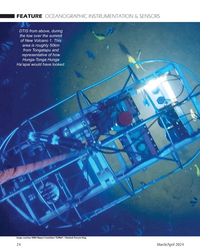 )
March 2024 - Marine Technology Reporter page: 24
)
March 2024 - Marine Technology Reporter page: 24FEATURE OCEANOGRAPHIC INSTRUMENTATION & SENSORS DTIS from above, during the tow over the summit of New Volcano 1. This area is roughly 50km from Tongatapu and representative of how Hunga-Tonga Hunga Ha’apai would have looked. Image courtesy NIWA-Nippon Foundation TESMaP / Rebekah Parsons-King 24
-
 )
March 2024 - Marine Technology Reporter page: 20
)
March 2024 - Marine Technology Reporter page: 202024 Editorial Calendar January/Februay 2024 February 2024 March/April 2024 Ad close Jan.31 Ad close March 21 Ad close Feb. 4 Underwater Vehicle Annual Offshore Energy Digital Edition ?2?VKRUH:LQG$)ORDWLQJ)XWXUH ?2FHDQRJUDSKLF?QVWUXPHQWDWLRQ 6HQVRUV ?6XEVHD'HIHQVH ?6XEVHD'HIHQVH7KH+XQWIRU ?0DQLS
-
 )
March 2024 - Marine Technology Reporter page: 19
)
March 2024 - Marine Technology Reporter page: 19About the Author vey with the pipe tracker is not required, resulting in signi? - Svenn Magen Wigen is a Cathodic Protection and corrosion control cant cost savings, mainly related to vessel charter. expert having worked across The major advantage of using FiGS on any type of subsea engineering, design
-
 )
March 2024 - Marine Technology Reporter page: 15
)
March 2024 - Marine Technology Reporter page: 15sensor options for longer mission periods. About the Author For glider users working in ? sheries and conservation, Shea Quinn is the Product Line Manager the Sentinel can run several high-energy passive and active of the Slocum Glider at Teledyne Webb acoustic sensors, on-board processing, and imaging
-
 )
March 2024 - Marine Technology Reporter page: 4
)
March 2024 - Marine Technology Reporter page: 4MTR again brought in it’s professional video team, and with that we Manager, Marketing recorded nearly two dozen interviews across most ever geographic local and product/tech Mark O’Malley [email protected] sector you could imagine; interviews that will ? ll our Marine Technology TV feed on Accounting w
-
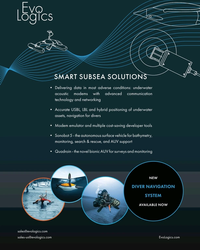 )
March 2024 - Marine Technology Reporter page: 2nd Cover
)
March 2024 - Marine Technology Reporter page: 2nd CoverSMART SUBSEA SOLUTIONS • Delivering data in most adverse conditions: underwater acoustic modems with advanced communication technology and networking • Accurate USBL, LBL and hybrid positioning of underwater assets, navigation for divers • Modem emulator and multiple cost-saving developer tools • Sonobot
-
 )
April 2024 - Maritime Reporter and Engineering News page: 39
)
April 2024 - Maritime Reporter and Engineering News page: 39Vessels (PSV) tender processes. Yara Clean Ammonia, Azane and Fjord Base will now commence work with their project partners to obtain a permit with the local municipality before a ? nal investment deci- sion. Image courtesy YCA www.marinelink.com 39 MR #4 (34-44).indd 39 4/5/2024 9:17:38 A
-
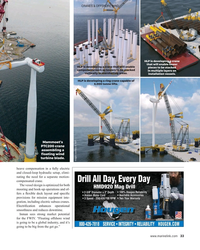 )
April 2024 - Maritime Reporter and Engineering News page: 33
)
April 2024 - Maritime Reporter and Engineering News page: 33CRANES & OFFSHORE WIND HLP is developing a crane that will enable tower HLP is developing a crane that will enable pieces to be stacked components such as towers to be stacked in multiple layers on vertically in marshalling areas. installation vessels. HLP is developing a ring crane capable of 6
-
 )
April 2024 - Maritime Reporter and Engineering News page: 32
)
April 2024 - Maritime Reporter and Engineering News page: 32FEATURE A closeup of a blade installation process taken via drone. A blade handling system is apparent (in yellow). Images courtesy of Mammoet requirement for the development of these cranes, particularly ling area. This would result in a major time and fuel saving. in ? oating offshore wind,” says
-
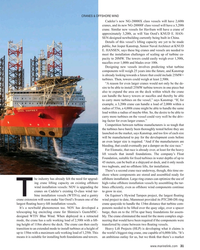 )
April 2024 - Maritime Reporter and Engineering News page: 31
)
April 2024 - Maritime Reporter and Engineering News page: 31CRANES & OFFSHORE WIND Cadeler’s new NG-20000X class vessels will have 2,600t cranes, and its new NG-20000F class vessel will have a 3,200t crane. Similar new vessels for Havfram will have a crane of approximately 3,200t, as will Van Oord’s KNUD E. HAN- SEN-designed newbuilding currently being built in
-
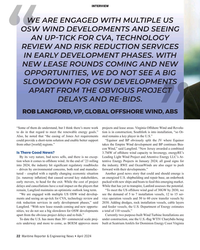 )
April 2024 - Maritime Reporter and Engineering News page: 22
)
April 2024 - Maritime Reporter and Engineering News page: 22INTERVIEW WE ARE ENGAGED WITH MULTIPLE US OSW WIND DEVELOPMENTS AND SEEING AN UP-TICK FOR CVA, TECHNOLOGY REVIEW AND RISK REDUCTION SERVICES IN EARLY DEVELOPMENT PHASES. WITH NEW LEASE ROUNDS COMING AND NEW OPPORTUNITIES, WE DO NOT SEE A BIG SLOWDOWN FOR OSW DEVELOPMENTS APART FROM THE OBVIOUS
-
 )
April 2024 - Maritime Reporter and Engineering News page: 21
)
April 2024 - Maritime Reporter and Engineering News page: 21he sees a need for further sup- port – incentives and subsidies – to develop ports and proj- Roadblocks on the Wind Path ects. “We need to help educate the local communities, help- Like most organizations in the maritime and offshore sec- ing them [especially government representatives] to better tors, renewable
-
 )
April 2024 - Maritime Reporter and Engineering News page: 16
)
April 2024 - Maritime Reporter and Engineering News page: 16MARKETS SOVs – Analyzing Current, Future Demand Drivers By Philip Lewis, Director of Research, Intelatus © Björn Wylezich/AdobeStock t a high-level, there are three solutions to transferring Lower day rate CTVs are often used for daily transfer of technicians from shore bases to offshore wind farms
-
 )
April 2024 - Maritime Reporter and Engineering News page: 15
)
April 2024 - Maritime Reporter and Engineering News page: 15hydro-acoustic design of a propulsor that delays cavitation meets its underwater noise limits. This will require specialized inception and cavitating area. The third approach should be test sites or specialized mobile underwater testing equipment. isolation mounting of a vibro-active equipment and
-
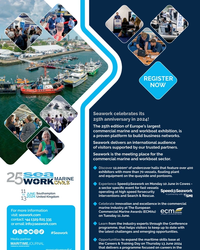 )
April 2024 - Maritime Reporter and Engineering News page: 7
)
April 2024 - Maritime Reporter and Engineering News page: 7REGISTER NOW Seawork celebrates its 25th anniversary in 2024! The 25th edition of Europe’s largest commercial marine and workboat exhibition, is a proven platform to build business networks. Seawork delivers an international audience of visitors supported by our trusted partners. Seawork is the
-
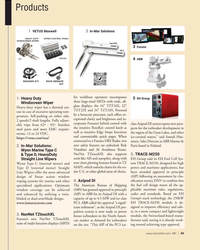 )
April 2024 - Marine News page: 43
)
April 2024 - Marine News page: 43Products 1 2 VETUS Maxwell In-Mar Solutions 3 Furuno ABB 4 for workboat operators encompasses EH Group 1. Heavy Duty 5 three large-sized MFDs with wide, all- Windscreen Wiper glass displays: the 16” TZT16X, 22” Heavy-duty wiper has a thermal cut- TZT22X and 24” TZT24X. Powered out in
-
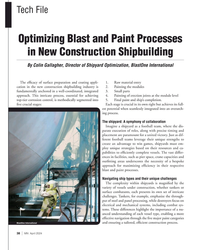 )
April 2024 - Marine News page: 38
)
April 2024 - Marine News page: 38Tech File Optimizing Blast and Paint Processes in New Construction Shipbuilding By Colin Gallagher, Director of Shipyard Optimization, BlastOne International The ef? cacy of surface preparation and coating appli- 1. Raw material entry cation in the new construction shipbuilding industry is 2. Painting
-
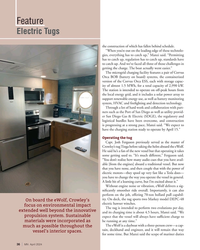 )
April 2024 - Marine News page: 36
)
April 2024 - Marine News page: 36Orca ESS, each with storage capac- ity of almost 1.5 MWh, for a total capacity of 2,990 kW. The station is intended to operate on off-peak hours from the local energy grid, and it includes a solar power array to support renewable energy use, as well as battery monitoring system, HVAC and ? re? ghting and
-
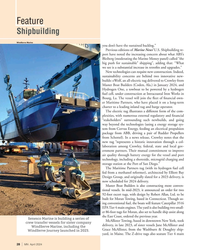 )
April 2024 - Marine News page: 28
)
April 2024 - Marine News page: 28Schottel). In a news release, Crowley notes that the new tug “represents a historic innovation through a col- laboration among Crowley, federal, state and local gov- ernment partners. Their mutual commitment to improve air quality through battery energy for the vessel and port technology, including a shoreside
-
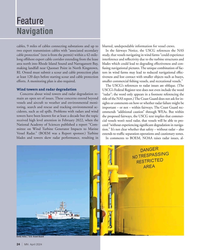 )
April 2024 - Marine News page: 24
)
April 2024 - Marine News page: 24Feature Navigation cables, 9 miles of cables connecting substations and up to blurred, undependable information for vessel crews. two export transmission cables with “associated secondary In the fairways Notice, the USCG references the NAS cable protection” (text is from the permit) within a 42-mile-
-
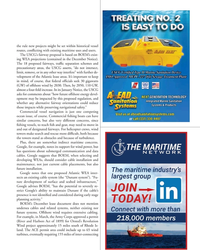 )
April 2024 - Marine News page: 23
)
April 2024 - Marine News page: 23the rule new projects might be set within historical vessel routes, con? icting with existing maritime uses and users. The USCG’s fairway proposal is based on BOEM’s exist- ing WEA projections (contained in the December Notice). The 18 proposed fairways, traf? c separation schemes and precautionary
-
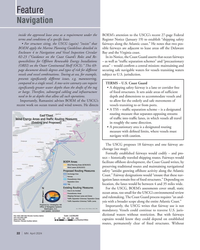 )
April 2024 - Marine News page: 22
)
April 2024 - Marine News page: 22Feature Navigation inside the approved lease area as a requirement under the BOEM’s attention to the USCG’s recent 27-page Federal terms and conditions of a speci? c lease. Register Notice (January 19) to establish “shipping safety • For structure siting, the USCG (again) “insists” that fairways along
